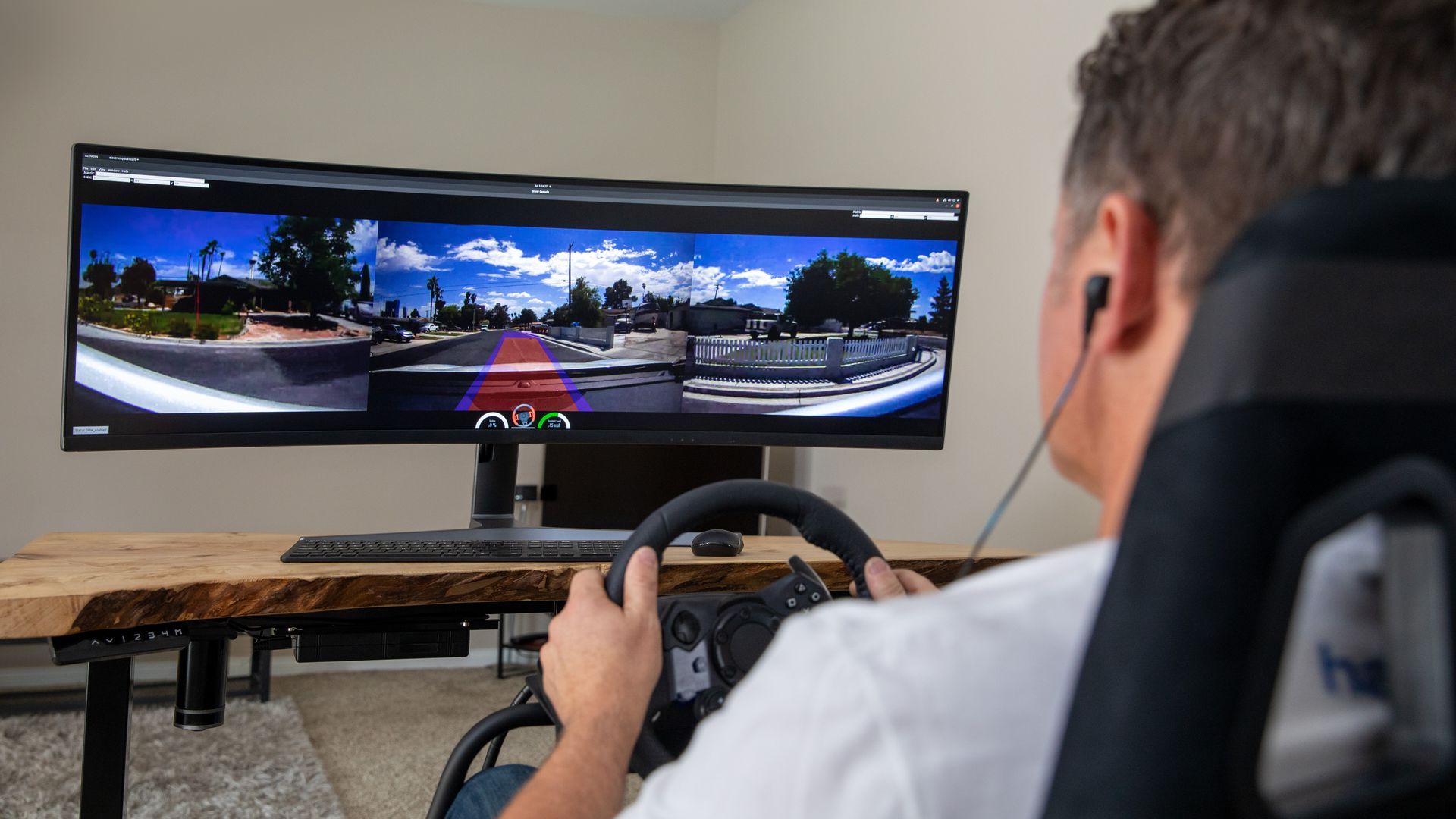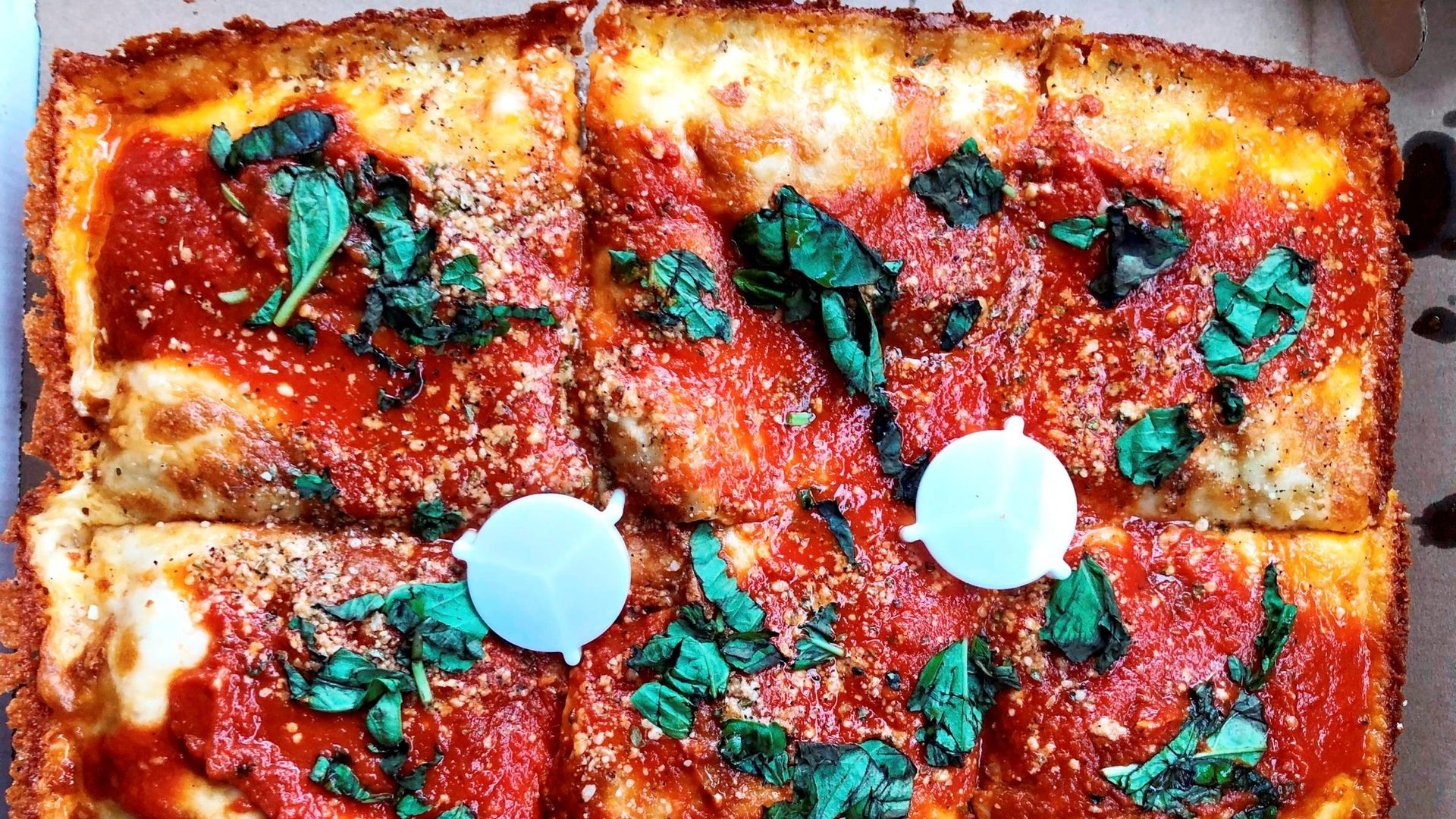| | | | | | | Presented By Babbel | | | | Axios What's Next | | By Bryan Walsh, Erica Pandey and Joann Muller ·Jul 09, 2021 | | Today we're delivering a new approach to driverless cars, AI that can scan your writing for potentially biased language, and pizza. So much pizza. "What was next" trivia: On this day in 2002, who won baseball's All-Star Game? ⚾️ - Credit to reader Gary Kreissman for being the first to note that John L. Sullivan's title fight in 1889 was the last bare-knuckled boxing match. 🥊
- Send your answer, along with tips and feedback, to whatsnext@axios.com.
Today's Smart Brevity count: 1,334 words ... 5 minutes. | | | | | | 1 big thing: "Driverless" cars arrive in Las Vegas via remote control |  | | | Halo's remote operators deliver driverless cars in Las Vegas via T-Mobile's 5G network. Photo courtesy of T-Mobile | | | | A new ride-hailing service in Las Vegas is targeting people who are curious about autonomous vehicles but aren't yet ready to climb into the back seat and let a robot drive, writes Joann Muller. Why it matters: Electric AVs promise to make urban transportation safer, more affordable and more accessible, potentially easing congestion and cutting carbon emissions. - But earning the public's trust is a challenge, so a handful of cities like Las Vegas are tiptoeing toward the robotaxi era.
What's happening: In the Phoenix suburbs, people can summon a driverless Waymo minivan, but only in certain neighborhoods. Within a year or so, other companies, including Cruise and Argo AI, could have limited robotaxi services operating in parts of San Francisco and Miami. - And in Las Vegas, one lesser-known company called Halo will deliver a car by remote control, then let users drive it away.
How it works: A rider uses the Halo app to summon an electric Kia Niro SUV. - A driverless Halo arrives at the pickup location and the rider hops in the driver seat and drives to his or her destination.
- When the driver arrives, there's no need to park; he or she just exits the vehicle and the Halo moves on to its next pickup location.
Between the lines: Halo's "driverless" cars in fact have a human driver — they are tele-operated by specially trained operators sitting miles away behind a computer screen, using a steering wheel, foot pedals and other controls. - Tele-operation hinges on a strong 5G network to ensure there are no signal interruptions that could delay the operator's response to real-world situations.
- Halo worked closely with T-Mobile in Las Vegas to build out a reliable 5G network to support its driverless cars.
- "Imagine a remote pilot driving virtually," says Halo founder and CEO Anand Nandakumar. "The video should be seamless, with no freeze frames. Every packet we push from the car has to be reliably received on the car's console, really fast."
Reality check: Halo lags behind most other AV companies. But its unique business model could help it catch up. - "Full autonomy is a massive challenge from both a technical and social trust perspective that won't be solved for years to come," said Nandakumar.
- Halo's plan is to build automation over time, starting with a service that consumers can feel comfortable using today.
- Using artificial intelligence, the cars will train themselves by learning from real customers' driving decisions.
- "Every mile the customer drives, the AI is learning in the background," he says.
The bottom line: AAA found that 54% of drivers are afraid to ride in a self-driving car — and another 32% are unsure about it. - As with most innovations, real-world experience could eventually win them over.
Share this story. |     | | | | | | 2. An automated tool to police offensive language |  | | | Illustration: Eniola Odetunde/Axios | | | | A startup has developed an AI tool that can copyedit written text with an eye toward specific corporate style and potentially offensive language, writes Bryan Walsh. Why it matters: The shift to distributed work means employees are spending more time communicating internally and externally in writing, even as norms for what's acceptable in workplace speech keep evolving. - AI tools powered by improving natural language processing (NLP) can help automate that oversight — even if in practice it can feel a little intrusive.
What's happening: San Francisco-based Writer's AI tool scans through written text of all kinds — emails, Slack messages, blog posts — to identify not just grammatical or spelling mistakes, but language that clashes with a company's preferred style or could come across as potentially biased. - "We think of ourselves as the single source of truth for language that's been approved strategically by a company," says May Habib, Writer's CEO.
How it works: As a user writes, Writer will highlight problematic or weak language and offer possible alternatives. - Write a message along the lines of "Is that the best you can do?," and Writer will identify it as potentially passive-aggressive.
- Use a term like "blacklist," and it can get flagged as potentially biased.
Details: Customers — which include large firms like Deloitte — can tweak Writer's out-of-the-box style guides to their specifications, says Habib. The big picture: Writer is one of a number of automated writing assistants on the market, including Grammarly and Textio — a sign of both the growing importance of written communication in the digital age and the growing ability of machines to do some of that work for us. Share this story. |     | | | | | | 3. Rising wages may not be enough for hospitality workers |  | | | A waiter at a restaurant in Manhattan, where hospitality businesses are struggling to find workers. Photo: Amir Hamja/Bloomberg via Getty Images | | | | A new survey finds that the majority of job seekers are not interested in working in the hospitality sector, writes Bryan. Why it matters: Even as most remaining pandemic restrictions are being dropped, bars and restaurants are struggling to find enough workers to meet demand — and simply increasing wages may not do the job. By the numbers: 60% of job seekers say they would not consider working in a bar, restaurant, hotel or other hospitality industry position for their next job, according to a new survey from Joblist. - Though job seekers with previous hospitality experience are more open to another position in the sector, 38% of former hospitality workers say they are not even considering a job in the industry.
- While restaurants and bars have been raising wages in an attempt to lure back workers, pay doesn't seem to be the main factor — over 50% of former hospitality workers say that no pay increases or incentives would make them return to their old job.
The bottom line: Don't expect the hospitality sector's staffing woes to let up any time soon. |     | | | | | | A message from Babbel | | Here's a skill you can show off this summer | | |  | | | | Travel, friends, adventures – it's happening. Get ready with Babbel and start having conversations in a new language – such as Spanish, Italian, or Portuguese – in as little as 3 weeks. Get 60% off during their 4th of July sale. Sign up today. | | | | | | 4. Digital health funding booms |  | | | Illustration: Sarah Grillo/Axios | | | | The money was flowing in digital health in the first half of this year, already outpacing funding rounds in the entirety of 2020, according to a report out this week from Rock Health, writes Tina Reed. The big picture: Digital health funding is accelerating — in the total number of deals and in size. For instance, in the first six months of 2021, $14.7 billion in funding went to companies in 372 rounds. - That is up from $14.6 billion in 2020 on 460 deals. It's also up from $7.7 billion in 2019 on 383 deals.
- The average deal size in the first half of 2021 was $39.6 million in funding with 48 mega-rounds or rounds of $100 million or more.
- The average deal size in 2020 was $31.7 million with a total of 44 mega-rounds and the average deal size was $20.1 million with a total of 11 mega-rounds in 2019.
Among the largest rounds in the first half was $540 million in a Series F round by weight loss company Noom. It was also one of the largest single rounds in digital health history, Rock Health said. |     | | | | | | 5. What's next: Another slice |  | | | What Getty Images informs me is a "Detroit-style pizza pie." Photo: Corin Hirsch/Newsday RM via Getty Images | | | | Yesterday's edition included what should be the final word on the finest pizza in all the land: F&F Pizzeria in Brooklyn, writes Bryan. The other side: Despite that unassailable argument, my fellow newsletter writers and some of our readers have their own takes. Erica Pandey: It's hard to make a name for yourself in the New Haven pizza scene with stalwarts like Pepe's and Sally's already dominating, but Modern Apizza arguably does pizza better. Just the plain cheese pie is heaven. Credit: Modern Apizza Scott Rosenberg: Bistro Don Giovanni has been baking Neapolitan pizzas in its oven in Napa, California, for more than two decades, since long before that style became fetishized. And they're still perfect. Credit: Bistro Don Giovanni Joann Muller: Buddy's Detroit-style pizza is truly the best — which is why everyone is copying it. It's square, and built upside-down, with the pepperoni smothered under crumbled brick cheese, and the sauce ladled on top. The crunchy, cheesy corners are incredible. No contest. Credit: Buddy's Detroit Of note: Readers sent in some of their own nominations. - Golden Boy's in San Francisco: "Lines out the wazoo every day of the week!" — Arjun Shah
- Pizza Village in Lafayette, Louisiana: "The perfect marriage of ingredients." — Marti Thomas
- Lou Malnati's in Chicago: "For complete indulgence, the stuffed pizza." — Johanna Cummings
The bottom line: The only thing better than arguing about which of these pizzas is best is eating them. |     | | | | | | A message from Babbel | | Here's a skill you can show off this summer | | |  | | | | Travel, friends, adventures – it's happening. Get ready with Babbel and start having conversations in a new language – such as Spanish, Italian, or Portuguese – in as little as 3 weeks. Get 60% off during their 4th of July sale. Sign up today. | | | | One correction from yesterday's edition, thanks to eagle-eyed reader Bob Kraai: Nathan Myhrvold should be the "doyen of molecular gastronomy," not the "doyenne." Thanks for reading! If this email was forwarded to you, subscribe here! |  | | It'll help you deliver employee communications more effectively. | | | | | | Axios thanks our partners for supporting our newsletters. If you're interested in advertising, learn more here.
Sponsorship has no influence on editorial content. Axios, 3100 Clarendon Blvd, Suite 1300, Arlington VA 22201 | | | You received this email because you signed up for newsletters from Axios.
Change your preferences or unsubscribe here. | | | Was this email forwarded to you?
Sign up now to get Axios in your inbox. | | | | Follow Axios on social media:    | | | | | |
No comments:
Post a Comment